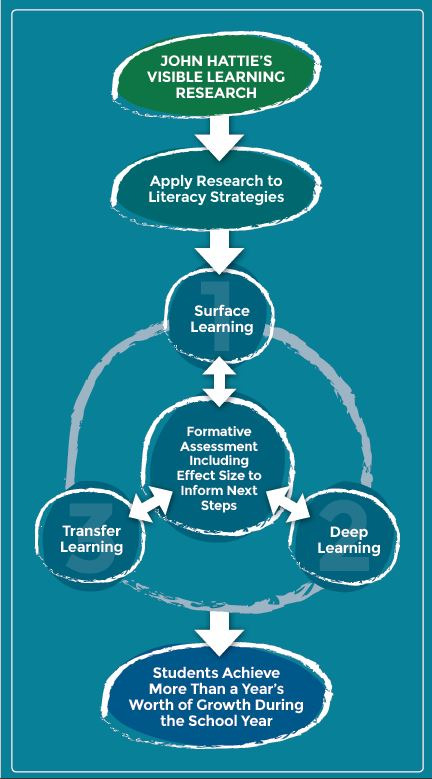You are here
VLL Workshops
VISIBLE LEARNING FOR LITERACY INTRODUCTORY WORKSHOP
This workshop demonstrates how using the right approach at the right time can help you more intentionally design classroom experiences that hit the surface, deep, and transfer phases of learning. This workshop covers Visible Learning research, its connections to surface, deep, and transfer learning as it relates to literacy, the most impactful approaches to use in each stage of learning, and the tools for measuring your impact on student learning.
Learning Outcomes
Participants will:
- Apply the principles of Visible Learning research to the literacy classroom.
- Understand the three phases of learning and the unique importance of each: surface, deep, and transfer.
- Learn which literacy practices have the greatest impact on student growth (and which have the least) to maximize and strategize teaching time.
- Strategize what practices to implement at the right time in a student’s learning, while keeping rigor in mind.
- Assess the impact of one’s teaching on one’s students—and what to do next as a result.
DETERMINING IMPACT IN LITERACY
What if we talked a bit less about teaching, and a bit more about learning? This workshop explores more deeply the importance of the effect sizes of different high impact approaches, and how to calculate your own effect size for classes and individual students. Learning how to determine your impact will build your sense of efficacy as well as empower you to share with peers and build collective teacher efficacy—the most effective strategy of all! This workshop will also review effective components of successful Response to Intervention (RTI) including screening, quality core instruction, progress monitoring, as well as supplemental and intensive intervention.
Learning Outcomes
Participants will:
- Apply the principles of Visible Learning research to the literacy classroom
- Determine their impact by calculating effect size
- Review effective RTI components
- Reflect upon the impact of their teaching and move forward in purposeful planning
SURFACE LEARNING IN LITERACY
Surface learning isn’t superficial. A key foundation of surface learning is skills and concept development which sets the stage for deeper learning. This workshop focuses on practical approaches for surface learning through acquisition and consolidation using the Visible Learning research. Walk through different approaches and participate in demonstrated techniques that promote surface learning.
Learning Outcomes
Participants will:
- Apply the principles of Visible Learning research to the literacy classroom
- Understand the importance of surface learning and the two sub-phases (acquisition and consolidation)
- Learn which literacy practices have the greatest impact on student growth at this learning phase (and which have the least) to maximize learning
- Strategize what practices to implement for surface learning, keeping rigor in mind
DEEP LEARNING IN LITERACY
Once students have consolidated surface learning, teachers can encourage learners to plan, investigate, and elaborate on their learning. This will nurture deep learning. This workshop focuses on practical approaches for deep learning using the Visible Learning research as a guide. Walk through different approaches and participate in the exercises that promote deeper learning.
Learning Outcomes
Participants will:
- Apply the principles of Visible Learning research to the literacy classroom
- Understand the learning phases and how to move from surface learning to deep learning
- Learn which literacy practices have the greatest impact on student growth (and which have the least) to maximize teaching time
- Strategize what practices to implement for deep learning, while keeping rigor in mind
TRANSFER LEARNING IN LITERACY
All learning is transfer learning, provided understanding is involved. This workshop explores the importance of transfer learning, the paths that transfer learning can take, and the conditions needed for transfer. This workshop will also review strategies for teaching students to organize and transform conceptual knowledge.
Learning Outcomes
Participants will:
- Apply the principles of Visible Learning research to the literacy classroom
- Understand the transfer phase of learning and the two types of transfer learning: near and far
- Examine the paths for transfer learning: Low-Road Hugging and High-Road Bridging
- Learn how to set the conditions for transfer of learning
- Learn strategies for teaching students to organize and transform
KEYNOTE
Educators have been in search of “what works” for decades. Our collective search for better ways to reach students and ensure that they develop knowledge and skills has resulted in thousands of books, hundreds of thousands of research articles, and countless websites. The truth is, nearly all things teachers do work when we ask what improves student achievement. But a smaller number of appraches work at ensuring that students gain a full year’s worth of growth for a year of enrollment in school. We think it’s time we focused on what works, what doesn’t work, and what can’t hurt. To do this, we turned to John Hattie and his Visible Learning research (Hattie, 2009, 2012) for help. With him, we wrote Visible Learning for Literacy (Fisher, Frey, & Hattie, 2016). As this work makes clear, students must develop surface-level knowledge if they are ever going to go deep. And we know that deep learning can facilitate transfer, which has been a goal shared by educators for as long as there have been teachers. Timing is everything, and using the right strategy for the phase of learning ensures a year’s worth of progress for a year in school.
Ready to get started?
Request a custom proposal from your Professional Learning Advisor.
